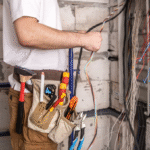In healthcare settings, lighting is more than just a source of illumination; it plays a critical role in patient care, staff performance, and overall operational efficiency. With the rising costs of healthcare services, many facilities are looking for innovative ways to reduce expenses without compromising the quality of care. One solution that has gained significant attention is energy-efficient healthcare lighting. Not only does it reduce energy consumption and lower operational costs, but it also enhances the overall environment, benefiting both patients and healthcare providers.
In this blog, we’ll explore how energy-efficient healthcare lighting can save costs while improving the quality of care in medical environments.
The Importance of Healthcare Lighting
Lighting in healthcare facilities must meet several essential needs. It provides visibility for medical tasks, contributes to patient comfort and healing, and supports staff in delivering high-quality care. However, traditional lighting systems often come with high energy demands, resulting in increased operational costs for hospitals and other healthcare facilities.
Energy-efficient lighting options, such as LED (Light Emitting Diode) technology, have transformed the way healthcare facilities approach lighting. By optimizing energy use and enhancing functionality, these lighting systems provide a range of benefits that contribute to a healthier, more sustainable healthcare environment.
How Energy-Efficient Healthcare Lighting Reduces Costs
1. Lower Energy Consumption
The most immediate and obvious benefit of energy-efficient healthcare lighting is its ability to significantly reduce energy consumption. Traditional lighting systems, such as incandescent or fluorescent bulbs, consume large amounts of electricity, leading to high energy bills. In contrast, energy-efficient LED lighting consumes far less power while producing the same—or better—light output.
In healthcare facilities where lights are often on 24/7, these savings add up quickly. According to industry research, LED lighting can use up to 75% less energy than traditional lighting options, resulting in substantial long-term savings. For healthcare facilities, where operating budgets are tight, these savings can be redirected to other areas of patient care.
2. Longer Lifespan of Lighting Systems
Energy-efficient healthcare lighting solutions, particularly LEDs, have a much longer lifespan compared to traditional lighting systems. While incandescent bulbs may last only a few months and fluorescent bulbs may last a year or two, LED lights can last up to 25,000 to 50,000 hours. This means fewer replacements and lower maintenance costs over time.
In a busy healthcare environment, reducing the frequency of lighting maintenance is critical. Changing light bulbs in areas such as operating rooms, patient rooms, and hallways can be disruptive and costly. By investing in energy-efficient lighting with a longer lifespan, healthcare facilities can reduce downtime and minimize maintenance costs, leading to further savings.
3. Reduced HVAC Load
Lighting systems not only consume electricity directly but also generate heat, which can increase the cooling load on HVAC (Heating, Ventilation, and Air Conditioning) systems. Traditional lighting, particularly incandescent and halogen bulbs, can emit significant amounts of heat, raising the temperature of rooms and requiring more cooling to maintain a comfortable environment.
Energy-efficient lighting, such as LEDs, emits very little heat compared to traditional options. This reduction in heat output lowers the demand on HVAC systems, resulting in additional energy savings. For healthcare facilities that require strict climate control for patient comfort and equipment function, this can be a significant advantage.
4. Rebates and Incentive Programs
Many regions offer rebates and incentive programs to encourage the adoption of energy-efficient technologies, including lighting. Healthcare facilities that invest in energy-efficient lighting may qualify for these programs, further reducing the upfront costs of installation. These rebates can provide immediate savings, making the transition to energy-efficient lighting more financially accessible.
Improving Patient Care with Energy-Efficient Healthcare Lighting
While cost savings are a major driver for healthcare facilities to adopt energy-efficient lighting, the impact on patient care is equally important. Energy-efficient lighting solutions are designed not only to reduce energy use but also to improve the overall healthcare environment. Here’s how:
1. Enhanced Patient Comfort
Lighting has a significant effect on patient comfort, mood, and recovery. Harsh, overly bright lights can cause discomfort and increase stress, especially for patients who are already dealing with physical or emotional challenges. Energy-efficient lighting systems, particularly those with adjustable brightness levels and color temperatures, can create a more soothing and welcoming environment.
For example, LED lighting can be adjusted to mimic natural light, helping to regulate patients’ circadian rhythms and improve sleep quality. This can be particularly beneficial for patients in long-term care or recovery settings, where a calming environment is essential for healing.
2. Improved Visibility for Healthcare Professionals
Healthcare professionals rely on proper lighting to perform tasks with precision and accuracy. Whether it’s conducting medical procedures, administering medication, or examining patients, the quality of light can directly impact the quality of care. Energy-efficient lighting systems provide high-quality, consistent light that enhances visibility and reduces eye strain, allowing healthcare staff to perform their duties more effectively.
Additionally, energy-efficient lighting can be customized to meet the specific needs of different areas within a healthcare facility. For example, operating rooms require intense, focused lighting, while patient rooms benefit from softer, ambient lighting. The flexibility of energy-efficient lighting systems ensures that each area of the facility is optimally lit for its intended purpose.
3. Environmental Impact and Sustainability
In addition to reducing operational costs and improving patient care, energy-efficient healthcare lighting contributes to a facility’s sustainability goals. By consuming less energy, these lighting systems reduce the facility’s carbon footprint, making healthcare operations more environmentally responsible. In an era where sustainability is increasingly prioritized, energy-efficient lighting is a practical solution for healthcare providers to meet environmental standards.
Conclusion
Energy-efficient healthcare lighting offers a winning combination of reduced costs and improved care. By lowering energy consumption, extending the lifespan of lighting systems, and reducing the load on HVAC systems, healthcare facilities can save money while maintaining a high standard of care. Additionally, energy-efficient lighting enhances patient comfort, supports healthcare professionals in their work, and contributes to a more sustainable healthcare environment.
As healthcare facilities continue to seek ways to balance financial sustainability with quality care, energy-efficient healthcare lighting stands out as a key solution to meet both goals.


